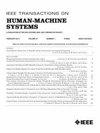Efficacy Assessments of Virtual Reality Systems for Immersive Consumer Testing—Two Case Studies With Tortilla Chip Evaluations
IF 4.4
3区 计算机科学
Q2 COMPUTER SCIENCE, ARTIFICIAL INTELLIGENCE
引用次数: 0
Abstract
In sensory science, the use of immersive technologies has gained popularity for their ability to restore relevant contextual factors during consumer testing and overcome the low ecological validity of controlled laboratory environments. Despite this, there is scant literature evaluating the effectiveness of immersive technologies in facilitating virtual product evaluation experiences; this is especially true with virtual reality (VR) headsets and the unique technical challenges associated with this technology. To fill this gap, we assessed virtual presence, system usability, engagement, and ease of task completion, in subjects using two iterations of a VR application (controllers or hand tracking) designed to address the major limitations of current systems. Results revealed that both systems exceeded the benchmark usability score of 68. System 1 (controllers) performed better for interactions with the virtual tablet interface to answer questions, whereas interactions with the food objects were easier using System 2 (hand tracking). Participants also experienced a high sense of virtual presence using both systems. When measured in System 2, a high level of subject engagement during the immersive product evaluations was observed. These studies indicate that collecting both quantitative and qualitative feedback on VR systems can provide useful insights and directions for application optimization to ensure valid investigation of context effects in future research.沉浸式消费者测试的虚拟现实系统效能评估——两个玉米饼片评估案例研究
在感官科学中,沉浸式技术的使用已经获得了普及,因为它们能够在消费者测试期间恢复相关的背景因素,并克服受控实验室环境的低生态有效性。尽管如此,很少有文献评估沉浸式技术在促进虚拟产品评估体验方面的有效性;对于虚拟现实(VR)头显以及与该技术相关的独特技术挑战来说,尤其如此。为了填补这一空白,我们评估了虚拟存在、系统可用性、参与度和任务完成的便利性,在使用VR应用程序(控制器或手部跟踪)的两次迭代的受试者中,旨在解决当前系统的主要局限性。结果显示,这两个系统都超过了基准可用性得分68分。系统1(控制器)在与虚拟平板电脑界面互动回答问题时表现更好,而使用系统2(手部追踪)与食物物体的互动更容易。参与者在使用这两种系统时也都体验到了高度的虚拟存在感。当在系统2中测量时,在沉浸式产品评估期间观察到高水平的受试者参与。这些研究表明,收集VR系统的定量和定性反馈可以为应用优化提供有用的见解和方向,以确保在未来的研究中有效地研究情境效应。
本文章由计算机程序翻译,如有差异,请以英文原文为准。
求助全文
约1分钟内获得全文
求助全文
来源期刊

IEEE Transactions on Human-Machine Systems
COMPUTER SCIENCE, ARTIFICIAL INTELLIGENCE-COMPUTER SCIENCE, CYBERNETICS
CiteScore
7.10
自引率
11.10%
发文量
136
期刊介绍:
The scope of the IEEE Transactions on Human-Machine Systems includes the fields of human machine systems. It covers human systems and human organizational interactions including cognitive ergonomics, system test and evaluation, and human information processing concerns in systems and organizations.
 求助内容:
求助内容: 应助结果提醒方式:
应助结果提醒方式:


